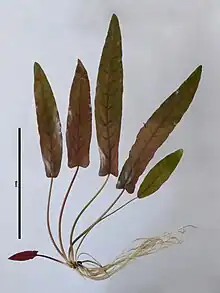Barclaya
Barclaya is a genus of six species of flowering plants of the family Nymphaeaceae.[1] Barclaya are aquatic plants native to tropical Asia. The genus was named in honour of the American-born English brewer and patron of science Robert Barclay.[2][3]
| Barclaya | |
|---|---|
 | |
 | |
| Barclaya longifolia | |
| Scientific classification | |
| Kingdom: | Plantae |
| Clade: | Tracheophytes |
| Clade: | Angiosperms |
| Order: | Nymphaeales |
| Family: | Nymphaeaceae |
| Genus: | Barclaya Wall. |
| Synonyms[1] | |
| |
Synonym
Though Hydrostemma is a name that is older than the name Barclaya, having been published 6 months earlier, the name Barclaya has been "conserved" as it was deemed being much better known than Hydrostemma.[4]
Taxonomy
Rejected classification
The separate family Barclayaceae H.L.Li was published in 1955.[5] It has been believed to be separate, due to the extended perianth tube (combined sepals and petals) arising from the top of the ovary and by stamens that are joined basally. However, morphological and genetic studies support the position of Barclaya in the family Nymphaeaceae.[6] A separate order Barclayales Doweld was proposed in 2001.[7][8]
The accepted placement of Barclaya is within the family Nymphaeaceae of the order Nymphaeales.[9]
Description
Plants grow from egg-shaped tubers that produce short runners and a basal rosette of leaves. All leaves are submerged.[2]
Cytology
The chromosome count of Barclaya longifolia is n=17.[10]
Species
| Flower | Species[1] | Distribution |
|---|---|---|
 | Barclaya longifolia Wall. | Indochina |
| Barclaya motleyi Hook.f. | Indonesia (Irian Jaya, Kalimantan, Sumatra), New Guinea (Idei 2010), Peninsular Malaysia | |
| Barclaya panchorensis Komala | Malaya Peninsula[11] | |
| Barclaya rotundifolia M.Hotta | Sarawak, Johore, Malaysia[12] | |
| Barclaya rugosa Sofiman Othman & N.Jacobsen | Malaya Peninsula[13] | |
| Barclaya wellyi Wongso, Ipor & N.Jacobsen | Sumatra[14] | |
Habitat
Within tropical rainforests, Barclaya develops alongside streams or at their fringes. The escalating deforestation across Southeast Asia is causing the habitats to become clouded, endangering Barclaya.[15]
Cultivation
Barclaya longifolia is a popular aquarium plant.[16][4][17] Under high light conditions the attractive, upright foliage displays green colouration. Under lower light conditions brownish foliage is produced.[18] It easily sets seed in cultivation, if pollen is deposited on the stigma.[19]
References
- "Barclaya Wall". Plants of the World Online. Royal Botanic Gardens, Kew. Retrieved 30 June 2023.
- Slocum, Perry D. (2005). Waterlilies and Lotuses: Species, Cultivars and New Hybrids. Timber Press. ISBN 978-0-88192-684-2. Archived from the original on 2008-05-08. Retrieved 2008-12-30.
- Wallich, Nathaniel (1827). "Description of a new genus of plants belonging to the order Nymphaeaceae". Transactions of the Linnean Society of London. 15: 442–448, Tab. 18. doi:10.1111/j.1095-8339.1826.tb00125.x.
- Crusio, W. E.; J. Bogner (1984). "Proposal to conserve 2515 Barclaya against Hydrostemma (Nymphaeaceae)". Taxon. 33 (3): 517–519. doi:10.2307/1221000. JSTOR 1221000.
- "Barclayaceae H. L. Li". Indices Nominum Supragenericorum Plantarum Vascularium. Global Biodiversity Information Facility. Retrieved 25 July 2023.
- Schneider, E. L. (1978). "Studies of the Nymphaeaceae. IX. The Seed of Barclaya longifolia Wall". Botanical Gazette. 139 (2): 223–230. doi:10.1086/336993. JSTOR 2473739. S2CID 85279142.
- "Family Barclayaceae - Hierarchy". The Taxonomicon. Universal Taxonomic Services. Retrieved 25 July 2023.
- Reveal, J. L.; Chase, M. W. (18 February 2011). "APG III: Bibliographical Information and Synonymy of Magnoliidae". Phytotaxa. 19 (1): 71–134. doi:10.11646/phytotaxa.19.1.4.
- Borsch, T., Löhne, C., & Wiersema, J. (2008). "Phylogeny and evolutionary patterns in Nymphaeales: integrating genes, genomes and morphology." Taxon, 57(4), 1052-4E.
- Chen, Fei; Liu, Xing; Yu, Cuiwei; Chen, Yuchu; Tang, Haibao; Zhang, Liangsheng (2017). "Water lilies as emerging models for Darwin's abominable mystery". Horticulture Research. 4: 17051. doi:10.1038/hortres.2017.51. PMC 5626932. PMID 28979789.
- "Barclaya panchorensis Komala". Plants of the World Online. Royal Botanic Gardens, Kew. Retrieved 30 June 2023.
- Jacobsen, Niels; Ipor, Isa B.; Bogner, Josef (2007). "Über die Kultur von Barclaya-Arten (Nymphaeaceae)". Aqua Planta. 32: 86–93.
- "Barclaya rugosa Sofiman Othman & N.Jacobsen". Plants of the World Online. Royal Botanic Gardens, Kew. Retrieved 30 June 2023.
- "Barclaya wellyi Wongso, Ipor & N.Jacobsen". Plants of the World Online. Royal Botanic Gardens, Kew. Retrieved 30 June 2023.
- Endress, P. K., & Friis, E. M. (2012). Early evolution of flowers. Springer Science & Business Media.
- Les, D. H. (2001). "Nymphaeales". e LS.
- Bailey, Mary; Burgess, Peter (1999). Tropical Fishlopaedia: A Complete Guide to Fish Care. Ringpress. ISBN 978-1-86054-102-5.
- Alderton, David (2019-02-07). Encyclopedia of Aquarium and Pond Fish. Dorling Kindersley Limited. ISBN 978-0-241-44442-9.
- Miller, Philip (1835). The gardeners dictionary.
External links
- Barclaya motleyi pictures Archived 2011-01-07 at the Wayback Machine